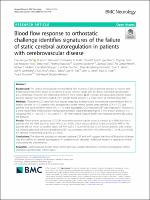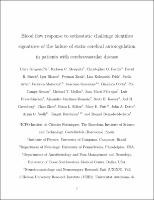| dc.contributor | Vall d'Hebron Barcelona Hospital Campus |
| dc.contributor.author | Gregori-Pla, Clara |
| dc.contributor.author | Mesquita, Rickson C. |
| dc.contributor.author | Favilla, Christopher G. |
| dc.contributor.author | Busch, David R. |
| dc.contributor.author | Blanco, Igor |
| dc.contributor.author | Zirak, Peyman |
| dc.contributor.author | Maruccia, Federica |
| dc.date.accessioned | 2021-12-17T13:15:17Z |
| dc.date.available | 2021-12-17T13:15:17Z |
| dc.date.issued | 2021-04-09 |
| dc.identifier.citation | Gregori-Pla C, Mesquita RC, Favilla CG, Busch DR, Blanco I, Zirak P, et al. Blood flow response to orthostatic challenge identifies signatures of the failure of static cerebral autoregulation in patients with cerebrovascular disease. BMC Neurol. 2021 Apr 9;21:154. |
| dc.identifier.issn | 1471-2377 |
| dc.identifier.uri | https://hdl.handle.net/11351/6711 |
| dc.description | Cerebral autoregulation; Cerebrovascular disease; Diffuse optics |
| dc.description.abstract | Background
The cortical microvascular cerebral blood flow response (CBF) to different changes in head-of-bed (HOB) position has been shown to be altered in acute ischemic stroke (AIS) by diffuse correlation spectroscopy (DCS) technique. However, the relationship between these relative ΔCBF changes and associated systemic blood pressure changes has not been studied, even though blood pressure is a major driver of cerebral blood flow.
Methods
Transcranial DCS data from four studies measuring bilateral frontal microvascular cerebral blood flow in healthy controls (n = 15), patients with asymptomatic severe internal carotid artery stenosis (ICA, n = 27), and patients with acute ischemic stroke (AIS, n = 72) were aggregated. DCS-measured CBF was measured in response to a short head-of-bed (HOB) position manipulation protocol (supine/elevated/supine, 5 min at each position). In a sub-group (AIS, n = 26; ICA, n = 14; control, n = 15), mean arterial pressure (MAP) was measured dynamically during the protocol.
Results
After elevated positioning, DCS CBF returned to baseline supine values in controls (p = 0.890) but not in patients with AIS (9.6% [6.0,13.3], mean 95% CI, p < 0.001) or ICA stenosis (8.6% [3.1,14.0], p = 0.003)). MAP in AIS patients did not return to baseline values (2.6 mmHg [0.5, 4.7], p = 0.018), but in ICA stenosis patients and controls did. Instead ipsilesional but not contralesional CBF was correlated with MAP (AIS 6.0%/mmHg [− 2.4,14.3], p = 0.038; ICA stenosis 11.0%/mmHg [2.4,19.5], p < 0.001).
Conclusions
The observed associations between ipsilateral CBF and MAP suggest that short HOB position changes may elicit deficits in cerebral autoregulation in cerebrovascular disorders. Additional research is required to further characterize this phenomenon. |
| dc.language.iso | eng |
| dc.publisher | BMC |
| dc.relation.ispartofseries | BMC Neurology;21 |
| dc.rights | Attribution 4.0 International |
| dc.rights.uri | http://creativecommons.org/licenses/by/4.0/ |
| dc.source | Scientia |
| dc.subject | Circulació cerebral |
| dc.subject | Malalties cerebrovasculars - Fisiologia patològica |
| dc.subject.mesh | Cerebrovascular Circulation |
| dc.subject.mesh | Cerebrovascular Disorders |
| dc.subject.mesh | /physiopathology |
| dc.title | Blood flow response to orthostatic challenge identifies signatures of the failure of static cerebral autoregulation in patients with cerebrovascular disease |
| dc.type | info:eu-repo/semantics/article |
| dc.identifier.doi | 10.1186/s12883-021-02179-8 |
| dc.subject.decs | circulación cerebrovascular |
| dc.subject.decs | trastornos cerebrovasculares |
| dc.subject.decs | /fisiopatología |
| dc.relation.publishversion | https://doi.org/10.1186/s12883-021-02179-8 |
| dc.type.version | info:eu-repo/semantics/publishedVersion |
| dc.audience | Professionals |
| dc.contributor.organismes | Institut Català de la Salut |
| dc.contributor.authoraffiliation | [Gregori-Pla C, Blanco I, Zirak P] ICFO-Institut de Ciències Fotòniques, The Barcelona Institute of Science and Technology, 08860 Castelldefels, Barcelona, Spain. [Mesquita RC] Institute of Physics, University of Campinas, Campinas, Brazil. [Favilla CG] Department of Neurology, University of Pennsylvania, Philadelphia, USA. [Busch DR] Departments of Anesthesiology and Pain Management and Neurology, University of Texas Southwestern Medical Center, Dallas, USA. [Maruccia F] Unitat de Recerca en Neurotraumatologia i Neurocirurgia UNINN, Vall d’Hebron Institut de Recerca (VHIR), Barcelona, Spain. Vall d’Hebron Hospital Universitari, Barcelona, Spain. Universitat Autònoma de Barcelona, Bellaterra, Spain |
| dc.identifier.pmid | 33836684 |
| dc.identifier.wos | 000639123800002 |
| dc.relation.projectid | info:eu-repo/grantAgreement/ES/PE2013-2016/RD16%2F0019%2F0010 |
| dc.relation.projectid | info:eu-repo/grantAgreement/ES/PE2013-2016/DPI2015–64358-C2–1-R |
| dc.relation.projectid | info:eu-repo/grantAgreement/ES/PE2013-2016/PRE2018-085082 |
| dc.relation.projectid | info:eu-repo/grantAgreement/ES/PE2013-2016/DTS16%2F00087 |
| dc.relation.projectid | info:eu-repo/grantAgreement/EC/H2020/654148 |
| dc.rights.accessrights | info:eu-repo/semantics/openAccess |


